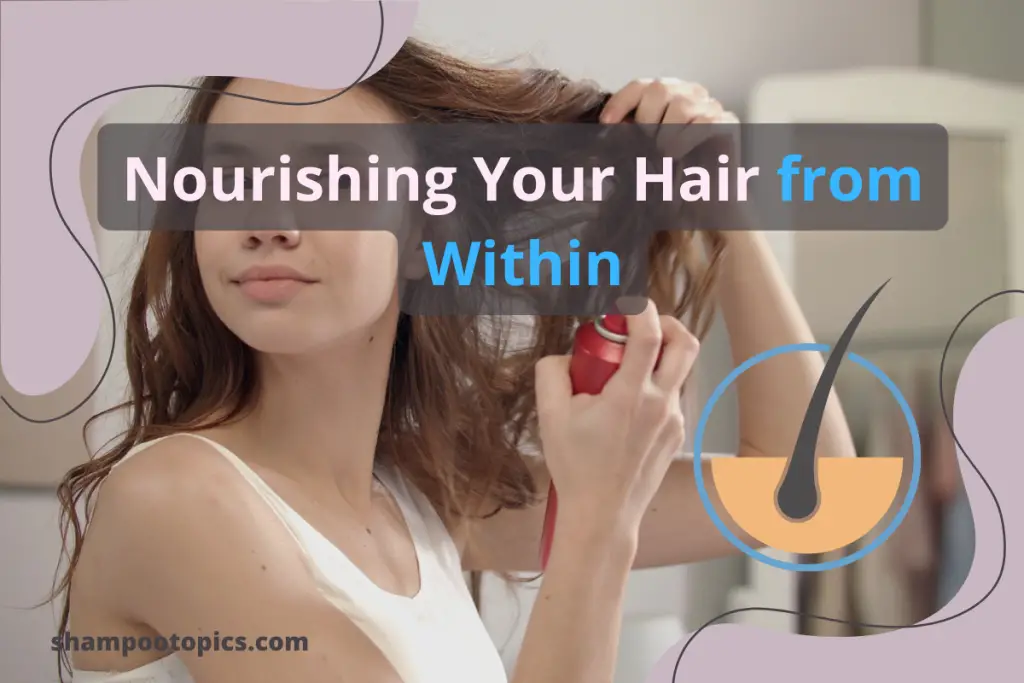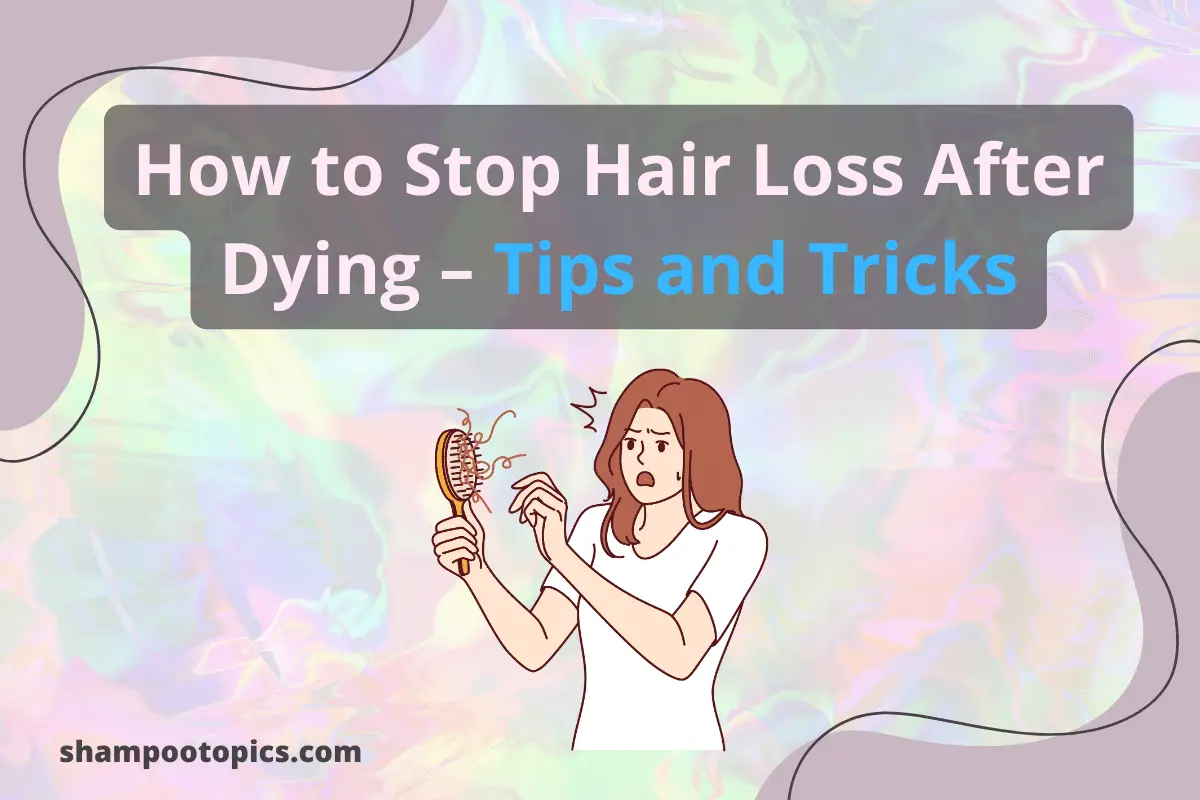I’m Amelia. I have been working with hair care product shampoo and conditioner for 6 long years. This website is...Read more

Are you worried about “how to stop hair loss after dying” your hair? You’re not alone! Many people experience this issue, but the good news is that it can be minimized with proper care and preventative measures.
In this blog post, we’ll explore the causes of hair loss after dyeing and provide practical tips and tricks related to how to stop hair loss after dying, to help you maintain the health and vibrancy of your colored hair.
Table of Contents
How to Stop Hair Loss After Dying?
- Understand causes of hair loss after dyeing, such as chemical damage and scalp irritation.
- Choose natural and organic dyes to reduce risk of hair damage. Use gentle washing & conditioning products.
- Take preventive measures like patch testing before dyeing, nourishing from within with essential nutrients & foods for growth, reducing stress levels & avoiding tight hairstyles.
Understanding Hair Loss After Dyeing

Stepping out of the hair salon with a fresh, bold color can be thrilling, but what happens when you notice strands of your newly-colored hair accumulating on your pillow or shower drain?
Hair loss after dyeing can be caused by various factors, such as chemical damage, scalp irritation, and weakened hair strands. Understanding these causes can help you minimize hair loss and maintain the gorgeous look you desire.
Being aware of the impact of hair dye chemicals on your hair is a key step in preventing hair loss after dyeing. These chemicals can cause damage to the hair shaft and cuticle, leading to hair breakage and, in severe cases, even temporary hair loss.
Furthermore, inappropriate hair dye application or choosing the wrong product for your hair type can exacerbate the problem. Therefore, taking the necessary precautions and following the appropriate steps is critical for maintaining the health and beauty of your dyed hair.
Chemical Damage

Chemical damage from hair dye ingredients can weaken hair and lead to breakage. Hydrogen peroxide and ammonia, commonly found in hair dyes, can damage the protein within the hair shaft, thus weakening it.
Additionally, hydrogen peroxide is used to oxidize melanin in hair, providing it with its natural color, but it can also lead to hair falling due to its damaging effects on hair structure.
Preventing hair loss caused by chemical damage can be achieved by seeking professional advice before dyeing your hair. This ensures that suitable products and techniques are used for your hair type.
Scalp Irritation
Scalp irritation from hair dye can cause hair loss, especially if an allergic reaction occurs. You should examine hair coloring products carefully to ensure they do not contain harsh chemicals like ammonia or parabens, which could contribute to hair loss.
Additionally, some hair dyes contain resorcinol that facilitates the permanent bonding of color to the hair but can also induce scalp irritation.
Using a mild hair dye, avoiding excessive dyeing, conducting a patch test before dyeing, and nourishing the hair with essential nutrients and foods can help stop hair fall after dyeing.
Weakened Hair Strands
Hair dye may weaken the structure of hair strands. As a result, they become more liable to breakage and hair loss. Some potential causes of weakened hair strands include:
- Damage to the hair cuticle
- Nutritional deficiencies
- Hormonal imbalances
- Oxidative damage
Permanent hair dyes are more likely to disturb the natural hairline and lead to hair loss. To avoid weakened hair strands, it is advisable to:
- Utilize a mild hair dye
- Abstain from excessive dyeing
- Conduct a patch test prior to dyeing
- Nourish the hair internally with essential nutrients and foods for hair growth.
Choosing the Right Hair Dye

Choosing the right hair dye can help minimize hair loss, with natural and organic options being safer alternatives. Natural hair colors, such as brown henna and vegetable-based dyes are ideal for those wanting to go the safe route. These choices will not contain any synthetic chemicals..
Semi-permanent hair dyes are another option, providing a temporary hue to the hair without lightening and lacking ammonia or any other bleaching compounds. Opting for natural, organic, or semi-permanent hair dyes can lower the risk of hair loss while keeping your colored hair healthy and vibrant.
Natural and Organic Options
Natural and organic hair dyes are less likely to cause hair loss and damage compared to synthetic dyes. Natural hair dyes are sourced from plants. They do not contain any synthetic chemicals.
Some examples of natural hair dye formulations include cassia powder, henna powder, and indigo leaf powder to modify hair color. Utilizing henna offers various benefits for hair health and may even assist in damage restoration.
When opting for natural and organic hair dyes, make sure to purchase genuine products from trusted vendors.
Avoiding Harmful Ingredients
Avoiding harmful ingredients in hair dye, such as ammonia and PPD, can help prevent hair loss. These ingredients can result in irritation and harm to the hair and scalp, potentially causing hair loss.
Ammonia, PPD, and hydrogen peroxide are deleterious chemicals to abstain from in hair dye to avert hair loss.
When picking out hair dyes, thoroughly check the products for the absence of harsh chemicals like ammonia or parabens, which can strip your hair of its natural oils and leave it dry and brittle.
Caring for Dyed Hair

Proper care for dyed hair includes gentle washing, conditioning, deep treatments, and heat protection. Implementing hair masks may assist in restoring damaged hair by enhancing hair and scalp health, fortifying strands to reduce the risk of future breakages, and delicately repairing damaged tresses.
Additionally, limiting exposure to heat and using a protective spray may assist in avoiding hair loss. Incorporating these hair care practices can effectively lower your chances of hair loss while keeping your dyed hair healthy and vibrant.
Gentle Washing and Conditioning
Using gentle, sulfate-free shampoos and conditioners can help minimize hair loss after dyeing. Some benefits of using sulfate-free products include:
- They do not contain harsh detergents that can strip the hair of its natural oils
- They are less likely to cause damage to the hair
- They can help maintain the color and vibrancy of dyed hair
By using sulfate-free products, you can take better care of your hair and reduce the risk of hair loss after dyeing.
To use sulfate-free shampoos and conditioners:
- Apply a generous amount of the product to the scalp and hair.
- Massage it in.
- Rinse thoroughly.
- Following up with a conditioner can further nourish and protect your dyed hair.
Deep Conditioning Treatments
Regular deep conditioning treatments can help restore moisture and strength to dyed hair. To apply a deep conditioning treatment, follow these steps:
- Shampoo your hair with a gentle, sulfate-free shampoo.
- Apply the treatment to all strands of the hair, focusing on the ends.
- Leave the treatment on for the recommended amount of time (usually 5-10 minutes).
- Rinse out the treatment with cool water.
Using a deep conditioning treatment weekly can help restore moisture and strength to dyed hair.
Heat Protection and Styling
Protecting hair from heat and styling damage can help prevent hair loss after dyeing. Heat treatments may result in damage to hair strands and lead to hair fall.
To avoid hair loss caused by heat styling, use a heat protectant spray before using hot tools, such as curling irons or flat irons. Additionally, try to minimize the use of heat styling tools and opt for air-drying your hair whenever possible.
Incorporating these heat protection and styling practices can help reduce hair loss and keep your dyed hair healthy and vibrant.
Preventative Measures

Preventative measures, such as patch tests, professional consultations, and proper timing between dye sessions, can help minimize hair loss. Performing a patch test before using hair dye can help prevent allergic reactions and hair loss. Consulting with a professional hairstylist can help ensure proper hair dye application and minimize damage.
Additionally, waiting at least 4-6 weeks between dye sessions can help prevent hair loss and damage. Incorporating these preventative measures can help lower hair loss while maintaining the health and vibrancy of your dyed hair.
Patch Test
Performing a patch test before using hair dye can help prevent allergic reactions and hair loss. To perform a patch test:
- Apply a small amount of the dye to the hair behind the ear.
- Leave it for a period of 24-48 hours.
- If no irritation or allergic reaction occurs, it is safe to proceed with dyeing your hair.
Skipping the patch test can result in an allergic reaction or irritation, potentially leading to hair loss. Always perform a patch test before dyeing your hair to avoid unnecessary hair loss and discomfort.
Professional Consultation
Consulting with a professional hairstylist can help ensure proper hair dye application and minimize damage. A professional hair stylist or colorist has the expertise to:
- Evaluate your hair type, texture, and condition
- Recommend the most suitable dyeing techniques and products that will work well with your hair
- Assist you in selecting the correct hair color that complements your skin tone, eye color, and personal style
- Create custom color blends and highlights to attain the desired look
By consulting with a professional, you can achieve the best results and minimize the risk of hair damage.
A consultation with a professional can reduce the risk of damage and help you achieve a vibrant and long-lasting hair color.
Timing Between Dye Sessions
Waiting at least 4-6 weeks between dye sessions can help prevent hair loss and damage. This interval allows your hair the opportunity to recuperate from the chemicals present in the dye. Additionally, giving your hair time to recover can help prevent hair loss caused by excessive dyeing or overlapping applications.
Maintaining the recommended interval between dye sessions can contribute to the health and vibrancy of your colored hair and reduce hair loss.
Nourishing Your Hair from Within

Nourishing hair from within through essential nutrients and a healthy diet can promote hair growth and minimize hair loss. Consuming essential nutrients, such as vitamins, minerals, and proteins, can help support hair growth and health.
Additionally, a balanced and nutritious diet can stimulate hair growth and reduce hair loss. Focusing on nourishing your hair from within can help reduce hair loss and keep your dyed hair healthy and vibrant.
Essential Nutrients
Consuming essential nutrients can support hair growth and health. Some key nutrients for hair health include:
- Vitamin A: Helps sustain a healthy scalp and skin
- Vitamins B, C, and D: Facilitate healthy hair growth
- Iron: Facilitates the transportation of oxygen to the hair follicles
- Zinc: Encourages healthy hair growth and hinders hair loss
Including these nutrients in your diet can help promote strong and vibrant hair.
A diet rich in these essential nutrients can contribute to the health and vibrancy of your dyed hair and reduce hair loss.
Foods for Hair Growth
Eating foods rich in hair-boosting nutrients can help promote hair growth and minimize hair loss. Some examples include:
- Spinach: Rich in iron, which can support hair follicle health
- Oily fish (e.g. salmon): Contains omega-3 fatty acids that can help prevent hair loss
- Berries: Packed with antioxidants that can promote hair health
Incorporating these foods into your diet can contribute to healthier and stronger hair.
Berries are packed with antioxidants that can protect hair follicles from damage and promote healthy hair growth. Incorporating these nutrient-dense foods into your diet can provide the essential nutrients your hair needs to grow and remain healthy, minimizing hair loss after dyeing.
Addressing Other Causes of Hair Loss

Addressing other causes of hair loss, such as stress, hormonal imbalances, and harsh hairstyling practices, can help prevent hair loss after dyeing. Managing stress levels, undergoing regular check-ups to detect any hormonal imbalances or illnesses, and employing gentle hairstyling techniques can help you address other causes of hair loss.
Taking a comprehensive approach to hair care and addressing any underlying issues can effectively reduce hair loss and keep your dyed hair healthy and vibrant.
Stress Management
Managing stress through relaxation techniques and self-care can help prevent hair loss. Stress can trigger the production of cortisol, a hormone that can lead to hair follicles shrinking and halting hair growth. Some relaxation techniques that may be beneficial in reducing stress include:
- Deep breathing
- Yoga
- Meditation
- Progressive muscle relaxation
By incorporating these techniques into your daily routine, you can effectively manage stress and promote healthy hair growth.
Engaging in self-care practices such as:
- Obtaining adequate sleep
- Consuming a nutritious diet
- Exercising regularly
- Taking time for yourself
can also help reduce stress and support healthy hair growth.
Hormonal Imbalances
Addressing hormonal imbalances through medical intervention or lifestyle changes can help minimize hair loss. Hormonal imbalances can result in a range of medical issues, such as hair loss. Medical interventions for hormonal imbalances may include hormone replacement therapy, medications, and supplements.
Modifications to one’s lifestyle, including the reduction of stress, the consumption of a balanced diet, and the incorporation of regular exercise, may be beneficial in balancing hormones and diminishing hair loss.
Gentle Hairstyling Practices
Practicing gentle hairstyling techniques can help prevent hair loss after dyeing. Some tips include:
- Avoiding tight ponytails and extensions
- Avoiding using heavyweight products
- Using fingers to create volume instead of using heat tools
- Getting regular haircuts to prevent split ends
- Using conditioner to keep hair moisturized
- Considering protective styles to minimize damage
Implementing these techniques can help reduce the risk of hair loss after hair dyeing.
Incorporating these gentle hairstyling practices can help reduce hair loss and keep your dyed hair healthy and vibrant.
Summary
In conclusion, hair loss after dyeing can be minimized with proper care, preventative measures, and addressing underlying issues. By understanding the causes of hair loss, choosing the right hair dye, caring for dyed hair, and nourishing your hair from within, you can maintain the health and vibrancy of your colored hair.
Remember to consult with a professional hairstylist, perform a patch test, and follow gentle hairstyling practices to keep your hair looking its best. With these tips and tricks, you can confidently flaunt your dyed hair without fear of hair loss.
Frequently Asked Questions
How do you fix hair falling out after dying it?
To fix hair falling out after dying it, make sure to stop further dyeing and nourish your hair with good quality products. Regular trimming and avoiding heat treatments will help reduce damage and hair fall.
Will hair grow back after hair dye loss?
Hair dye can lead to temporary hair loss, however most of the time it is not permanent. Depending on the severity of the damage caused by the dye, it could take anywhere from 6 to 9 months for the hair to grow back. Nevertheless, before treating the problem, it is important to assess whether the hairs have been affected from the follicle or shaft.
Can hair dye cause hair loss?
Although hair dye can potentially cause hair loss due to chemical damage, scalp irritation, and weakened hair strands, proper care can help minimize it.
How can I address other causes of hair loss, such as stress and hormonal imbalances?
To address stress and hormonal imbalances as potential causes of hair loss, practice relaxation techniques, make lifestyle changes or seek medical intervention, and be gentle when styling your hair.

I’m Amelia. I have been working with hair care product shampoo and conditioner for 6 long years. This website is an outlet of my deep passion for hair, Shampoo and Conditioner. Basically, I'm here to guide you on shampoo and conditioner.

